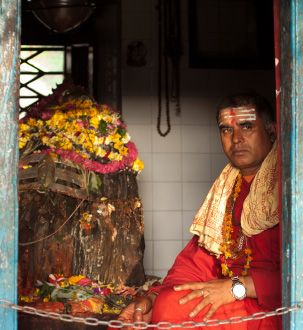 Hinduism is the third largest religion in the world, following Christianity and Islam. It encompasses a diverse collection of deities, beliefs, and practices; the various branches of Hinduism subsequently have vastly different takes on divinity, theism, and worship. Regardless of what denomination they belong to, Hindus are generally concerned with five prominent aspects of spirituality: Samsara (the cycle of life, death, and rebirth), Karma(the consequences of action), Dharma (ethics), Moksha (spiritual liberation), and Yogas (practices).
Hinduism is the third largest religion in the world, following Christianity and Islam. It encompasses a diverse collection of deities, beliefs, and practices; the various branches of Hinduism subsequently have vastly different takes on divinity, theism, and worship. Regardless of what denomination they belong to, Hindus are generally concerned with five prominent aspects of spirituality: Samsara (the cycle of life, death, and rebirth), Karma(the consequences of action), Dharma (ethics), Moksha (spiritual liberation), and Yogas (practices).
Hinduism's religious leaders are as varied as the religion itself. This article discusses only one of the many types of Hindu religious leaders, the pujari, who plays an integral role within their religion.
What is a Pujari?
Pujaris are learned religious leaders who know Sanskrit (the sacred language of Hinduism) and hundreds of mantras, chants, and rituals. They are temple priests who are considered to be particularly spiritually pure and blessed.
What Tasks do Pujaris Perform?
Every Pujari's primary task is to perform ceremonies called puja, meaning adoration or worship, which can last from ten minutes to ten hours. Most puja are addressed to pandits, high-level Hindu religious scholars, to recognize their extensive religious educations. For many Hindu temples, the puja's intricacies include specific rituals for cleansings, offerings, and blessings. These rites often require the use of mantras and special hand gestures.
Pujaris are mostly concerned with maintaining the sanctity of their temples and devote much of their time to meditation, personal worship, and caring for shrines and other parts of their temples. Because Hindu beliefs range from polytheistic to henotheistic (worshiping one god while acknowledging that others exist), the roles taken by pujaris within their temples vary from community to community.
Some temples have only one pujari, while others have teams of them. Like ministers of the Universal Life Church, pujaris often conduct life stage rituals, such as weddings and funerals, for the people who frequent their temples.
So How Do I Become Ordained as a Pujari?
Many Hindu temples have specific and stringent restrictions on who can become a pujari with them. In India, the largest Hindu country in the world, pujaris are historically from a social caste called the Brahmins; this group is the highest, "priest" caste. Today, India's traditional caste system is quickly changing and adapting to modern perspectives on self-determination and spiritual purity, so some temples are expanding their priesthood beyond the Brahmin class. Likewise, most traditions only allow male pujaris, but some newer traditions are embracing women as the ULC does.
Pujaris are generally trained from childhood by their parents and community leaders to become spiritual leaders. This training imparts knowledge about the rituals, chants, and mantras that they will use later in their career. Pujaris-in-training study scripture at great length and worship at temples, where they learn more about conducting rites and developing their own spirituality.
The process by which pujaris become ordained varies from tradition to tradition. Some pujaris become ordained in large, intricate ceremonies, while others do so in quick, intimate ones. Some pujaris never take part in a formal ordination rite and become ordained simply by leading worship when they feel like they are ready. A common sentiment amongst the practitioners of Hinduism is that it takes a spirituality devout person to perform a worship service for oneself or others.
Add Your Comment